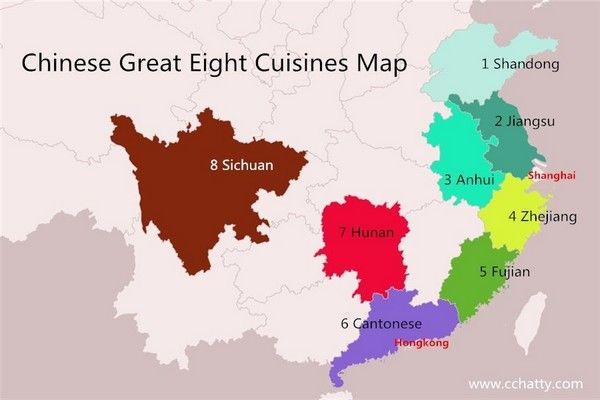China’s diverse culinary heritage is renowned worldwide for its rich flavors, regional specialties, and cultural significance. The country boasts a remarkable culinary landscape, with each region offering its unique culinary traditions and flavors. In this article, we delve into the eight major cuisines of China, exploring their distinct characteristics, ingredients, and cooking techniques. From the delicate flavors of Cantonese cuisine to the fiery spices of Sichuan cuisine, we invite you on a culinary journey to discover the incredible diversity of Chinese cuisine.
An Overview of Chinese Cuisine
a. Historical Significance: Chinese cuisine has a history spanning thousands of years and has played a vital role in Chinese culture, reflecting the country’s agricultural heritage, regional diversity, and cultural influences.
b. Yin-Yang Philosophy: Traditional Chinese cuisine embraces the concept of balance and harmony, emphasizing the harmony of flavors, colors, textures, and cooking techniques to achieve a well-rounded culinary experience.
Cantonese Cuisine
a. Overview: Originating from Guangdong province, Cantonese cuisine is one of the most well-known and influential culinary traditions in China. It is celebrated for its delicate flavors, emphasis on fresh ingredients, and skillful cooking techniques.
b. Key Characteristics: Cantonese cuisine highlights the natural flavors of ingredients, with a focus on steaming, stir-frying, and braising methods. It is renowned for its seafood dishes, dim sum, and emphasis on light sauces and broths.
Sichuan Cuisine
a. Overview: Hailing from the southwestern province of Sichuan, Sichuan cuisine is famous for its bold and spicy flavors. It is characterized by the unique use of Sichuan peppercorns, chili peppers, and a variety of aromatic spices.
b. Key Characteristics: Sichuan cuisine is known for its numbing and spicy sensations, achieved through the use of Sichuan peppercorns. It features a balance of flavors, including the famed “mala” (numbing and spicy) combination, and incorporates various cooking techniques such as stir-frying, braising, and dry-frying.
Shandong Cuisine
a. Overview: Originating from the coastal province of Shandong, Shandong cuisine is renowned for its fresh seafood, rich flavors, and emphasis on soups and broths. It is considered one of the oldest culinary traditions in China.
b. Key Characteristics: Shandong cuisine emphasizes the natural flavors of ingredients, highlighting the freshness and quality of seafood and vegetables. It is known for its clear broths, savory flavors, and a combination of cooking techniques, including quick-frying and stir-frying.
Hunan Cuisine
a. Overview: Hailing from the central province of Hunan, Hunan cuisine is known for its bold and spicy flavors, similar to Sichuan cuisine. However, it distinguishes itself with its use of smoked and cured ingredients, as well as its love for chili peppers.
b. Key Characteristics: Hunan cuisine features an abundance of chili peppers, garlic, and fermented ingredients, resulting in fiery and robust flavors. It incorporates various cooking techniques, including stir-frying, deep-frying, and braising, to create intense and complex dishes.
Fujian Cuisine
a. Overview: Originating from the southeastern province of Fujian, Fujian cuisine showcases the region’s coastal influences and abundance of seafood. It is celebrated for its fresh flavors, umami-rich ingredients, and meticulous preparation techniques.
b. Key Characteristics: Fujian cuisine highlights the natural flavors of ingredients and features a balance of sweet, sour, savory, and umami flavors. It showcases the use of seafood, soups, and braised dishes, often incorporating ingredients such as mushrooms, bamboo shoots, and fermented soybeans.
Jiangsu Cuisine
a. Overview: Hailing from the eastern province of Jiangsu, Jiangsu cuisine is renowned for its meticulous preparation, delicate flavors, and elegant presentation. It is often associated with imperial cuisine and is regarded as one of China’s most sophisticated culinary traditions.
b. Key Characteristics: Jiangsu cuisine emphasizes the quality and freshness of ingredients and incorporates a range of cooking techniques, including braising, stewing, and quick-frying. It showcases the use of freshwater fish, crabs, and vegetables, resulting in refined and delicate flavors.
Zhejiang Cuisine
a. Overview: Originating from the coastal province of Zhejiang, Zhejiang cuisine is known for its emphasis on fresh and seasonal ingredients, light flavors, and delicate preparation techniques. It is often associated with health and well-being.
b. Key Characteristics: Zhejiang cuisine celebrates the natural flavors of ingredients, highlighting their freshness and quality. It incorporates various cooking methods, including steaming, braising, and quick-frying. Zhejiang cuisine is known for its seafood dishes, soups, and delicate flavors.
Conclusion
The eight major cuisines of China represent the incredible diversity and culinary heritage of the country. From the delicate and fresh flavors of Cantonese cuisine to the bold and fiery spices of Sichuan cuisine, each culinary tradition offers a unique gastronomic experience. Exploring the regional specialties, ingredients, and cooking techniques of these cuisines allows us to appreciate the cultural and historical significance they hold. Whether you embark on a culinary journey to sample these cuisines in China or savor their flavors in local Chinese restaurants worldwide, you are sure to be captivated by the rich tapestry of Chinese culinary traditions.


